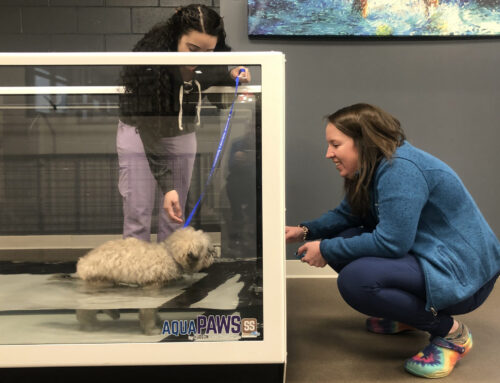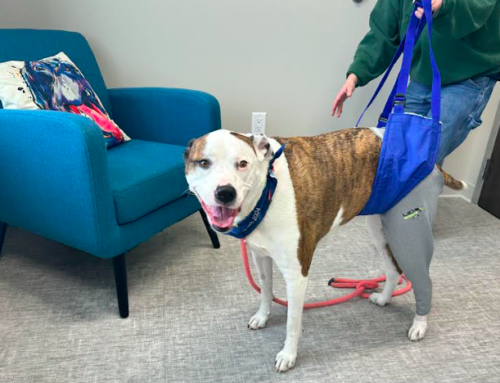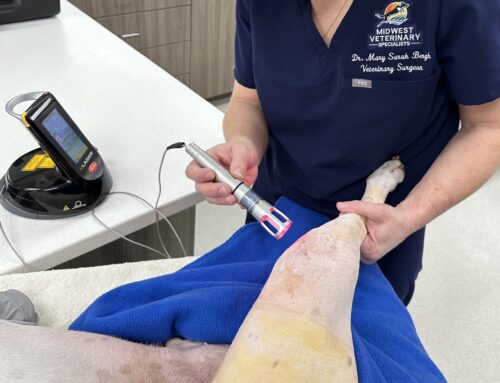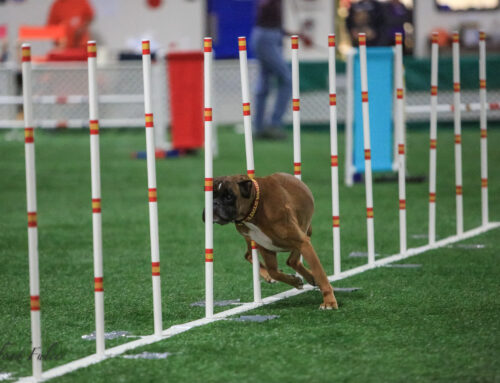Unmanaged pain decreases a pet’s quality of life and prolongs their recovery from surgery, injury, and illness. Pets instinctively hide their vulnerabilities, which can make recognizing pain difficult. Our Midwest Veterinary Specialists team wants to help by explaining how you can determine if your pet is suffering.
Understanding pet pain
Pain is a complex, multifaceted experience involving sensory and emotional components. Enduring pain is a subjective emotion that can occur without an obvious external noxious stimulus, and the experience can be modified by fear, memory, and stress. Pain causes a stress response mediated by the endocrine system. Increased cortisol, catecholamines, and inflammatory mediators cause increased heart rate and blood pressure, decreased gastrointestinal motility, delayed wound healing, and reduced immune responsiveness.
The simplest pain classification is acute or chronic. Acute pain lasts for a short time and disappears when the underlying cause is treated, whereas chronic pain persists beyond the normal healing time. Other pain classifications include:
- Adaptive pain — Adaptive (i.e., physiological) pain announces a potentially harmful stimulus, providing an essential protective function, and is the normal response to tissue damage.
- Maladaptive pain — In cases where adaptive pain is not managed appropriately, physiological and physical spinal cord and brain changes occur, and the pain serves no helpful function. This can lead to chronic syndromes in which the pain becomes the primary disease.
Recognizing dog pain
Pets feel pain for many reasons, including infections, dental disease, arthritis, gastrointestinal problems, injuries, and cancer, and also feel discomfort following surgical procedures. Unfortunately, pets cannot tell us when and where they hurt, although they can communicate through their behavior and body language. Dogs exhibit pain in the following ways:
- Vocalizing — A dog experiencing acute pain may yelp, howl, or whine, and dogs suffering from chronic pain conditions, such as arthritis, may grunt or groan when they move.
- Changes in daily habits — A painful dog may eat or drink less, sleep more, and show less interest in social interactions with people and other pets. Some painful dogs may seek more affection than usual.
- Changes in activity level — A painful dog may have a hard time finding a comfortable position, and may shift their weight repeatedly or appear restless. By contrast, a dog with a painful condition may have difficulty getting up from a sitting or lying position, and may be more reluctant to move. Painful dogs may also have difficulty navigating stairs, getting on and off furniture, or jumping into vehicles.
- Facial expressions — Painful dogs may pant excessively when resting, keeping their ears flattened. They also may have enlarged pupils and a glazed, vacant stare.
- Posture — Painful dogs may hunch their back, with their hindquarters raised and their front end closer to the ground.
- Limping — A dog with pain in a particular limb may hold the limb off the ground, limp when they walk, or shift weight off the leg when standing.
- Self-protection — Painful dogs may not want to be petted or held, and may hide.
- Aggression — A normally friendly dog may become aggressive and growl, pin their ears, and bite.
- Grooming — A painful dog may lick excessively at an area that is painful.
Recognizing cat pain
Cats often hide their pain. Their wild ancestors were vulnerable to predators if they exhibited illness or injury signs, and domestic cats have retained this trait. Subtle behavioral changes can indicate your cat is in pain. Cats exhibit pain in the following ways:
- Vocalizing — Painful cats may meow, growl, or hiss, but they also may purr. While purring is more commonly associated with being content, cats also purr when they are in pain, because the low frequency vibrations caused by purring helps the cat heal faster, research suggests.
- Changes in daily habits — Painful cats may eat or drink less, sleep more, and withdraw from social interactions.
- Inappropriate elimination — Painful cats may stop using their litter box and urinate or defecate elsewhere in the home.
- Grooming — Painful cats may stop grooming or groom less, resulting in an unkempt appearance.
- Self-mutilation — Painful cats may lick or bite a particular area, causing irritation or ulceration.
- Changes in activity level — Painful cats may hide more frequently and avoid being petted and picked up. In addition, painful cats may have difficulty jumping on and off surfaces, and you may notice they don’t leap as high.
- Facial expression — Painful cats may pant when resting and may furrow their brow, flatten their ears, and have dilated pupils.
- Posture — Painful cats may lie with their feet underneath their body.
- Irritability — Painful cats may be more irritable than usual, and growl or hiss uncharacteristically.
Addressing pet pain
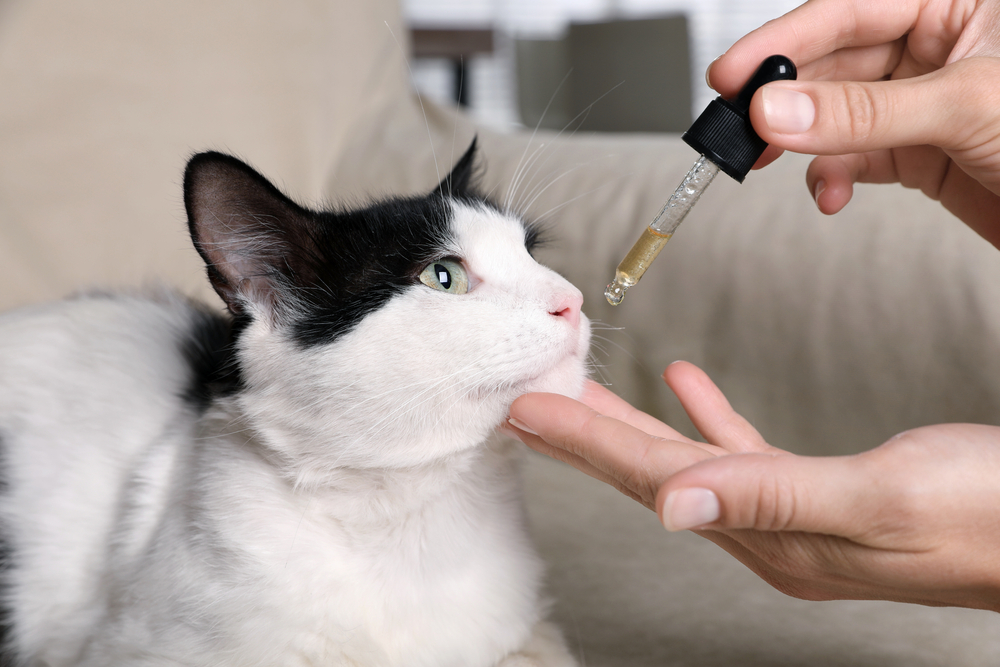
Pain management protocols are developed based on the cause of your pet’s pain, and many times a multi-modal approach provides the best pain relief. A few general pain management approaches include:
- Pain medications — Pain medications such as gabapentin and opioids are effective analgesic drugs for treating moderate to severe pain. They are widely used for chronic pain conditions as well as for surgery, and in emergency and critical care situations.
- Non-steroidal anti-inflammatories (NSAIDs) — NSAIDs are commonly used to treat mild to moderate pain and are prescribed for a wide array of conditions, including arthritis, cancer treatment, and post-operative pain.
- Joint supplements — High quality joint supplements can promote joint health and decrease pain associated with osteoarthritis.
- Rehabilitation exercises — Therapeutic rehabilitation exercises can improve blood and lymph flow, increase soft-tissue support to skeletal structures, and increase tendon and ligament pliability.
- Laser therapy — Low level laser therapy can decrease pain and increase function in certain conditions.
- Shockwave therapy — High-intensity sound wave therapy can treat inflammation, decrease pain, and help tendons, bones, and ligaments heal.
- Icing and warm packing — Cold and heat can provide local pain relief to a painful area.
- Weight management — Keeping your pet lean and fit can decrease the load on painful or arthritic joints.
No pet’s pain should go unmanaged. If your pet is exhibiting behavioral changes that suggest they are in pain, contact our Midwest Veterinary Specialists team, so we can determine the cause and devise an appropriate pain management plan to help your pet live his or her best life!



